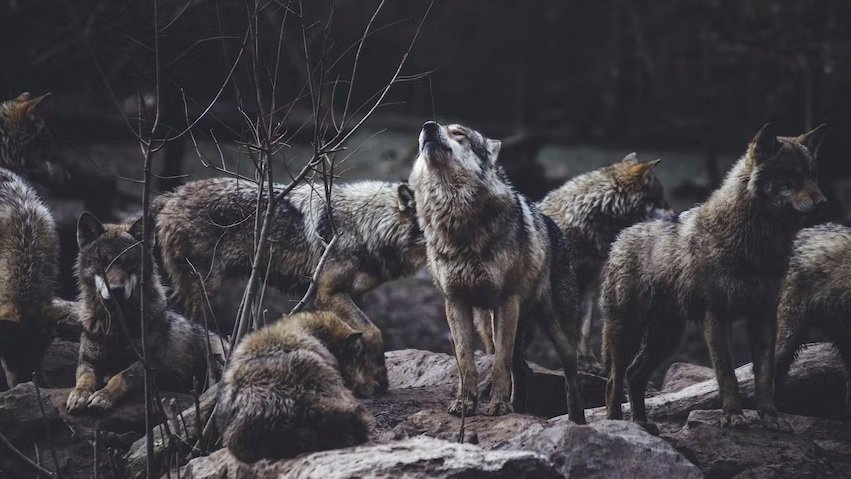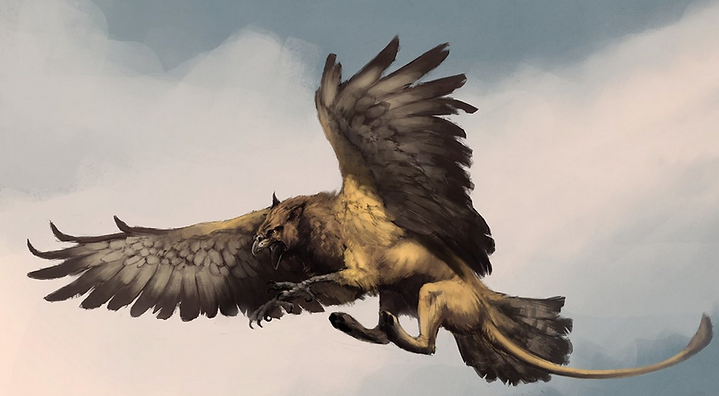Cryptids
Palmyra Wolves

A pack of wolves similar to the Palmyra Wolf Pack. Photo: IC You Photograhy
The Martin family in Palmyra, Maine had a terrifying experience being trapped in their home by five giant wolves that walked on two legs. What were these strange creatures?
The Martin’s Encounter with the Palmyra Wolves
A pack of wolves. Much smaller than the Palmyra Wolves. Photo: Unsplash.
Eric and Shelley Martin and their family lived in a quiet farm in Palmyra in rural Maine. The farm is surrounded by dense woods which the family loved to venture into for hunting. The family had an extensive collection of hunting weapons stored in their barn, locked away in a strongbox.
Eric headed out into the woods to investigate with his son Sean. As they got closer to the lights they suddenly went out. The men suddenly felt a feeling of extreme fear and decided to return home.
The following day The Martin’s daughter Chelsea and her boyfriend came to visit and went for a walk in the woods with the dogs. While they were walking the dogs caught on to a scent and ran after excitedly.
When Chelsea and Nathan caught up to the dogs they were sniffing around a big round hole in the ground that looked to perfect to be natural.
Nathan was curious and wanted to investigate further but Chelsea was too frightened and the couple returned to the farmhouse.
A few weeks later on Memorial Day weekend Shelley was making her evening coffee as usual. It was a particularly misty evening. Eric was trying to put the dogs in their kennels for the night but they didn’t want to leave his side. Something was frightening them.
Suddenly Eric heard a strange noise coming from the woods. Eric yelled out to Shelley to get back in the house. Shelley saw five sets of eyes stating back at them from the woods. They both rushed inside and locked the door.
The couple peered out the window to see five huge wolf-like creatures stalking around their garden. They were huge and Eric knew they weren’t bears. They alternated between walking upright on two legs and running on all four.
Shelley ran around the house closing all of the windows and locking the doors. The dogs were hiding together in a corner. Eric wanted to go to the barn to get his guns.
Eric went on the porch, heading to the barn. He saw the creatures standing there staring at him in the dark. He waved his arms around to get the security light to come on. The creatures lunged towards him but when they reached the light it was like something was holding them back. Eric abandoned his plan to get the guns and ran back inside.
The Martins called the police hoping to get some help but there was none to be had. The police refused to send anyone and told the family to just stay inside and keep all the doors and windows locked.
The Martins woke up the kids, grabbed any sharp instruments they could find and huddled together on the Eric and Shelley’s bed. When morning came the creatures were finally gone.
The following morning the family went outside to investigate. There was no sign of the creatures just huge footprints with enormous claws left in the mud. Many of the footprints belonged to a creature walking on just two feet.
The Martins aren’t the only people to have had experiences with very large, bipedal wolf-like creatures in rural Maine. There have been several very similar reports over the last few decades that are yet to be explained.
A video telling the story of the Palmyra Wolves
What were the Palmyra Wolves?
It’s possible that the Palmyra wolf pack and others that have been seen are a new species of bipedal wolf that has yet to be classified by science.
Some people theorise that there is a connection between cryptids and UFOs. Some even believe that these creatures could be coming from another dimension. In many stories including the Martin’s there were strange lights seen in the weeks before the wolf attack. Could these be related?
A more mundane explanation could be that the Martins simply encountered a normal wolf pack that just behaved a little strangely. Maybe the wolves had been poisoned or had brain issues that caused them to be unusually aggressive and walk on two legs. Wolves are often much bigger than people expect them to be if they have not encountered them often.
The Martin’s were experienced hunters so it seems likely they would be familiar with normal wolf behavior and be able to identify them.
What do you think the Palmyra Wolves were? Let us know in the comments.
If you enjoyed this article you might be interested in more werewolf like creatures like the Michigan Dogman or the Beast of Bray Road.
Cryptids
Mothman SIghted Before 2007 Bridge Collapse in Minnesota

The aftermath of the I-35w Bridge Collapse in 2007. Image: Wikipedia
Just like the infamous Silver Bridge Mothman sightings, witnesses claim seeing a strange, 7ft tall flying humanoid in the weeks before the collapse of the I-35W bridge in 2007.
The Collapse of the I-35W Bridge
The I-35W Mississippi River bridge (also known as Bridge 9340) was a large bridge in Minneapolis, Minnesota, that carried Interstate 35W over the river. It was built in 1967 and was one of the busiest bridges in Minnesota, with thousands of cars using it every day.
Sadly, on August 1, 2007, during the evening rush hour when hundreds of people were driving home from work, something terrible happened. The bridge suddenly collapsed, causing a lot of damage. Sadly, 13 people died, and 145 were injured.
Investigators later found out that a part of the bridge, called the gusset plate, had failed. The gusset plate was worn and the stress of the extra cars on the bridge caused it to break apart.
Right after the collapse, people and emergency workers from nearby areas rushed to help. They worked hard to rescue anyone who was trapped and to take care of the injured.
The Minnesota Department of Transportation quickly made plans to build a new bridge called the I-35W Saint Anthony Falls Bridge. They finished building it just over a year later, and it opened in September 2008.
Connections to the Silver Bridge Collapse
The Silver Bridge Collapse
For many cryptid enthusiasts, hearing of a bridge collapse immediately brings Mothman to mind. The Silver Bridge was a suspension bridge spanning the Ohio River, connecting Point Pleasant, West Virginia, and Gallipolis, Ohio. On December 15, 1967, during rush hour, the bridge suddenly collapsed, sending cars and people plunging into the icy waters below. The disaster claimed the lives of 46 individuals, making it one of the deadliest bridge collapses in American history.
In the months leading up to the tragedy, residents of Point Pleasant reported sightings of a mysterious creature dubbed the “Mothman.” Described as a large, winged humanoid with glowing red eyes, the Mothman sightings fueled speculation and fear in the community.
Following the Silver Bridge collapse, some people began to link the sightings of the Mothman to the disaster, suggesting that the creature was a harbinger of impending doom. This connection led to the Mothman becoming a legendary figure in cryptozoology and popular culture.
Both the Silver Bridge collapse and the I-35w collapse were caused by structural failures in the bridges. In the case of the Silver Bridge, the collapse was attributed to a single eyebar in the suspension chain that failed due to metal fatigue. In the I-35W collapse, a design flaw in the bridge’s gusset plates, combined with increased weight from construction materials and traffic, led to the catastrophic failure.
Mothman Sightings Connected to the I-35W Bridge Collapse
Dark Reocrds covers the I-35w brdge collapse
The I-35w collapse Mothman sightings differ from the Silver Bridge Mothman sightings in their frequency. Dozens of people around Pleasant Point reported strange sightings and unexplained paranormal or extraterrestrial activity in the months leading up to the Silver Bridge collapse. The sightings surrounding the I-35w collapse were mush less common.
On August 10, 2007, George Noory hosted the “Coast to Coast AM” program, where he spoke to several callers sharing their encounters with cryptids. Among these calls was one reporting a sighting on June 27th near Stewartville, Minnesota. The caller described seeing a 7-foot-tall, winged humanoid creature with a massive wingspan, roughly the width of her Ford vehicle. The sighting occurred approximately 90 miles from the I-35w bridge, just over a month before the bridge collapse.
There are references to multiple other sightings online but they seem to have been removed from the internet. A WIRED article from the time talks of numerous blog posts on the topic but the link no longer works. This article by Singular Fortean also alludes to their being multiple sightings but doesn’t provide references.
Skepticism
So it seems we just have the one account to work with here. It’s possible that the George Noory’s caller was just someone making up a story and looking for a bit of attention. The fact that the account didn’t come out until after the collapse of the I-35w bridge does take from its credibility.
It is also possible that the caller simple saw a large crane or other bird and misidentified their memory as the mothman following the bridge collapse.
What if it was Mothman?
If it was Mothman that was seen before the collapse of the I-35w bridge it leads us to more questions than answers. Is this Mothman the same creature that was seen before the Silver Bridge collapse? Could Mothman actually be a species of creature that is drawn to human disasters, particularly bridge collapses?
Tell us your theories in the comments.
If you enjoyed reading about Mothman and the I-35w bridge collapse you might be interested in our article on the original Mothman story or the blackbird of Chernobyl.
Cryptids
The Awful

The Awful cryptid as described by Vermont residents in 1925
In 1923, several residents of Berkshire and Richford, Vermont reported seeing a creature resembling a griffin, with a 20 foot wingspan and a serpentine tail.
“The Awful” Cryptid Sightings of 1925
Berkshire and Richford, Vermont are peaceful countryside towns located between Lake Champlain and Lake Memphremagog, near the Canadian Province of Quebec.
In 1925 several residents of these towns reported encounters with an unusual flying creature.
The creature was described as being similar to the mythical Griffin, with a grayish color, a 20-foot wingspan, a snake-like tail, and big claws capable of holding a medium sized dog. These strange sightings caused panic among the locals who came to dub the creature “the Awful”.
The first sightings of the mysterious creature were reported by two sawmill workers in Richford. As they crossed the main street bridge, they saw a very large beast on the nearby rooftop of the Boright building, glaring at them. According to the tale, one of the men was so scared that he had a heart attack out of fear. He had to be carried home but eventually recovered. However, for weeks afterward, he had nightmares about the creature, waking up his family with screams during the night.
In the following months, locals kept reporting sightings of this mysterious creature, causing fear and panic among residents. Farmers shared stories of it flying over their fields, and others saw it landing on their house rooftops. One resident, Oella Hopkins, experienced this when she was hanging laundry outside. The family dog got upset and started barking, and when Oella looked, she saw the creature, known as The Awful, perched on her farmhouse roof, staring at her. Terrified, Oella ran inside and hid under her bed for hours.
Later Sightings of “The Awful”
By the end of 1925, sightings of the creature became less frequent and almost stopped completely by 1928. Even though people thought it had disappeared, some locals claimed to see it every now and then since the 1920s. One such person was Lisa Maskell from Montgomery, who said she spotted the creature near Trout River when she was a child. When she saw a drawing of a pterodactyl later on, she thought it looked like the creature she saw and believed it resembled The Awful.
In 2006, there were a few new reports suggesting that The Awful might have returned to Northern Vermont. In October 2006, a person wrote in the County Courier about a respected person in Richford who saw the creature suddenly appear and grab a big black crow from a pine tree. The witness was surprised and said the creature flew around his house three times.
After this article, more people shared sightings. A woman remembered seeing the monster when she was about ten. It was in a tree near the Trout River, watching them with its strange beak, reminding her of a pterodactyl.
A dowser named Edith Green said people in Richford have been nervous about the creature for a long time.
An older man mentioned that the creature has been seen often in the Gibou area for the past 25 years, even recently. Locals usually leave it alone, and it leaves them alone, with a few exceptions.
A resident of East Richford said the creature has been spotted recently around the Slide Road area. He mentioned you can often hear it before seeing it, making a strange, low screaming sound and the flapping of its large wings when it’s close.
Despite its scary appearance, the creature was never known to attack people; it seemed more like it was just watching. There’s one account mentioning it flying over Berkshire Field near Lost Nation Road and appearing to hold a baby or a small animal, although it’s more likely to have been an animal.
William DeFalco covers the story of The Awful
Possible Explanations for the Awful
Assuming the reports of the Awful are not just a hoax or an old wives tale what else could be going on here? It’s possible that soe type of rare, large bird is lurking in the wilds of Vermont and is only seen very rarely due to a lack of numbers. The Awful could simple have been a particularly large owl or Eagle.
If paranormal in origin, the Awful does bear a small resemblence to the Mothman of West Virginia. Perhaps it continues to lurk in the shadows, waiting to come our and warn residents of impending doom.
What do you think about the Awful? Tell us your theories in the comments.
If you enjoyed learning about the Awful you might also be interested in the Lechuza, a strange owl-like creature or the Prime Hook Swamp Monster.
-

 Ghosts2 years ago
Ghosts2 years agoZozo: The Ouija Board Demon
-

 Space2 years ago
Space2 years agoScientists claim to have found the answer what existed before the Universe
-

 Ghosts2 years ago
Ghosts2 years agoOld Coot of Mount Greylock
-
Archaeology1 year ago
New discoveries at Ekʼ Balam during conservation works
-

 General3 years ago
General3 years agoUC San Francisco engaging in horrifying experiments, organ harvesting of live babies in the name of “science”
